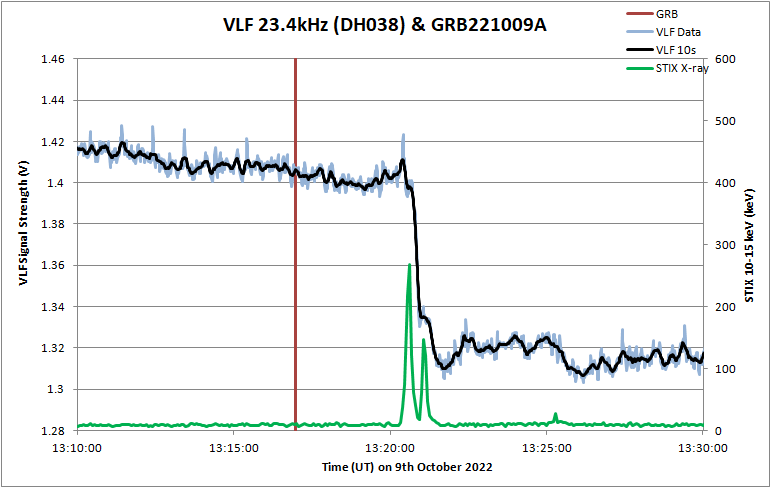On 9th October 2022 at 13:16:59 UT a strong Gamma Ray Burst (GRB) was detected by the Fermi Gamma-ray Space Telescope [1, 2], the Swift Gamma-Ray Burst Explorer [3, 4] as well as other gamma-ray and x-ray satellite detectors. GRB 221009A, at RA 19h 13m, Dec 19° 46’ [4] was unusually bright and long lasting and at estimated redshift of z=0.15 (1.9 billion light years). The ESA Solar Orbiter satellite [5] STIX instrument [6], for example, shows X-rays arriving some 3 minutes later.
The plot above shows the VLF 23.4 kHz data recorded at Galleywood, Essex using DH038 transmitter in Germany together the time GRB detection time (red line) and the STIX X-ray signal strength (green data). There is a strong correlation between the start of the drop in VLF signal strength and the first rise in X-rays at 13:20:36 UT, as well as a further drop in VLF signal strength at the time of the second X-ray peak. There may also be a further drop in VLF strength at the time of the third smaller X-ray peak at 13:25:16 UT.
It can be concluded that the X-rays from the GRB affected of the Earth’s ionosphere which was detected by a change in the propagation signal strength of the VLF signal from Germany to Galleywood. Note that GRB was above the horizon at both the transmitter and receiver locations at the time of the burst.
[1] https://fermi.gsfc.nasa.gov/science/instruments/gbm.html
[2] https://gcn.gsfc.nasa.gov/other/221009A.gcn3
[3] https://en.wikipedia.org/wiki/Neil_Gehrels_Swift_Observatory
[4] https://en.wikipedia.org/wiki/GRB_221009A
[5] https://www.esa.int/Science_Exploration/Space_Science/Solar_Orbiter
[6] https://datacenter.stix.i4ds.net/


